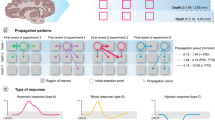Summary
Hypoxia, with or without hypercapnia, was induced by exposing rats to various gas mixtures for 45 min. In addition, some of the rats were exposed to electrical foot shocks for 15 min. Rats were either untreated by drugs or received inhibitors of catecholamine synthesis or metabolism. The adrenals and blood plasma were analyzed for dopa, and the adrenals for dopamine (DA) and adrenaline + noradrenaline.
Adrenal DA was elevated by severe (6 % O2) but was slightly decreased by moderate hypoxia (8 % O2). The addition of 5 % CO2 to 8 % O2 caused a moderate increase in DA. Foot shock stress raised adrenal DA under normoxia and the effect was markedly potentiated by moderate hypoxia. The accumulation of dopa in the adrenals of animals treated with 3-hydroxybenzylhydrazine (NSD 1015), an inhibitor of the aromatic amino acid decarboxylase, was closely correlated to the levels of adrenal DA in the corresponding experimental groups receiving no drug treatment, supporting the usefulness of adrenal DA as an indicator of catecholamine synthesis. In NSD 1015-treated rats dopa was found in the plasma and levels were increased after foot shock stress.
The data indicate that moderate hypoxia may retard the conversion of tyrosine to dopa, which may be related to the O2 requirement of this reaction. However, this effect can be overcome by neurogenic stimuli, presumably via an activation of adrenal tyrosine hydroxylase. Apparently such stimuli are induced by foot shock stress, severe hypoxia, hypercarbia and most markedly, by the combination of shock stress and hypoxia.
Similar content being viewed by others
References
Atack, C. V.: The determination of dopamine by a modification of the dihydroxyindole fluorimetric assay. Brit. J. Pharmacol.48, 699–714 (1973).
Atack, C. V., andT. Magnusson: Individual elution of noradrenaline (together with adrenaline), dopamine, 5-hydroxytryptamine and histamine from a single, strong cation exchange column by means of mineral acid organic solvent mixtures. J. Pharm. Pharmacol.22, 625–627 (1970).
Cantu, R. C., G. G. Nahas, andW. M. Manger: Effect of hypercapnic acidosis and of hypoxia on adrenal catecholamine output of the spinal dog. Proc. Soc. Exp. Biol. Med.122, 434–437 (1966).
Carlsson, A., J. N. Davis, W. Kehr, M. Lindqvist, andC. V. Atack: Simultaneous measurement of tyrosine and tryptophan hydroxylase activities in brainin vivo using an inhibitor of the aromatic amino acid de carboxylase. Naunyn-Schmiedeberg's Arch. Pharmacol.275, 153–168 (1972).
Carlsson, A., S. Snider, O. Almgren, andM. Lindqvist: The neurogenic short-term control of catecholamine synthesis and release in the sympatho-adrenal system, as reflected in the levels of endogenous dopamine andβ-hydroxylated catecholamines. In: Frontiers in Catecholamine Research. Proc. III. Int. Catecholamine Symp. (Usdin, E., andS. H. Snyder, eds.), pp. 551–556. New York: Pergamon Press. 1973.
Daniels, J., andJ. Chosy: Epinephrine and norepinephrine excretion during running training at sea level and altitude. Med. Sci. Sports4, 219–224 (1972).
Davis, J., andA. Carlsson: Effect of hypoxia on tyrosine and tryptophan hydroxylation in unanesthetized rat brain. J. Neurochem.20, 913–915 (1973 a).
Davis, J., andA. Carlsson: The effect of hypoxia on monoamine synthesis, levels, and metabolism in rat brain. J. Neurochem.21, 783–790 (1973 b).
Euler, U. S. von: Noradrenaline, p. 271. Springfield, Ill.: Charles C Thomas. 1956.
Fröberg, J., C.-G. Karlsson, L. Levi, andL. Lidberg: Physiological and biochemical stress reactions induced by psychosocial stimuli. Society, Stress and Disease1, 280–295 1971).
Kebr, W., A. Carlsson, andM. Lindqvist: A method for the determination of 3, 4-dihydroxyphenylalanine (DOPA) in brain. Naunyn-Schmiedeberg's Arch. Pharmacol.274, 273–280 (1972).
Moncloa, F., M. Gonez, andA. Hurtado: Plasma catecholamines at high altitudes. J. Appl. Physiol.20, 1329–1331 (1965).
Snider, S., andA. Carlsson: The adrenal dopamine as an indicator of adrenomedullary hormone biosynthesis. Naunyn-Schmiedeberg's Arch. Pharmacol.275, 347–357 (1972).
Author information
Authors and Affiliations
Additional information
With 1 Figure
Rights and permissions
About this article
Cite this article
Snider, S.R., Brown, R.M. & Carlsson, A. Changes in biogenic amine synthesis and turnover induced by hypoxia and/or foot shock stress I. The adrenal medulla. J. Neural Transmission 35, 283–291 (1974). https://doi.org/10.1007/BF02205225
Received:
Issue Date:
DOI: https://doi.org/10.1007/BF02205225




